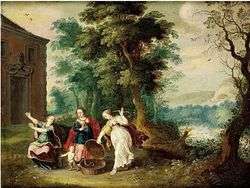Aglaurus, daughter of Cecrops

Aglaurus (/əˈɡlɔːrəs/; Ancient Greek: Ἄγλαυρος) or Agraulus was in Greek mythology the daughter of Cecrops and Aglaurus, daughter of Actaeus. She had two offspring by two different gods, Alcippe (with Ares) and Ceryx (with Hermes). There were numerous versions of her myth.[1]
Mythography
Taking the earliest first, Euripides Ion, lines 22–23; 484–485, mentions her, but in the Moses Hadas and John Mclean 1960 Bantam Classics translation they have Euripides say respectively: '(Athena) gave Erichthonius to Aglaurus' daughters (not sisters) to keep.' and later, speaking of "a haunt of Pan": "There the daughters of Aglaurus still tread the measures of their dance, on the green lawns before the shrine of Pallas (Athena)...".
According to the Bibliotheca, Hephaestus attempted to rape Athena but was unsuccessful. His semen fell on the ground, impregnating Gaia. Gaia did not want the infant Erichthonius, so she gave the baby to the goddess Athena. Athena gave the baby in a box to three women—Aglaurus and her two sisters Herse and Pandrosus—and warned them to never open it. Aglaurus and Herse opened the box. The sight of the infant caused them both to go insane and they threw themselves off the Acropolis,[2] or, according to Hyginus, into the sea.[3]
An alternative version of the same story is that, while Athena was gone bringing a limestone mountain from the Pallene peninsula to use in the Acropolis, the sisters, minus Pandrosus again, opened the box. A crow witnessed the opening and flew away to tell Athena, who fell into a rage and dropped the mountain (now Mt. Lykabettos). Once again, Herse and Aglaurus went insane and threw themselves to their deaths from a cliff.
Another legend represents Agraulos in a totally different light. Athens was at one time involved in a long and protracted war, and an oracle declared that it would cease if someone would sacrifice himself for the good of his country. Agraulos came forward and threw herself off the Acropolis. The Athenians, in gratitude for this, built her a temple on the Acropolis, in which it subsequently became customary for the young Athenians, on receiving their first suit of armor, to take an oath that they would always defend their country to the last.[4][5][6][7]
According to Ovid, Mercury loved Herse but her jealous sister, whom he calls Aglaurus, stood between them, barring Mercury's entry into the house and refusing to move. Mercury was outraged at her presumption and turned her to stone.[8]
Worship
One of the Attic demes (Agraule) derived its name from this heroine, and a festival and mysteries were celebrated at Athens in honor of her.[9][10][11] According to Porphyry, she was also worshiped in Cyprus, where human sacrifices were offered to her down to a very late time.[12] Mythographers believe Aglaurus to have an origin distinct from that of her sisters, due in part to the fact that she had her own sanctuary near the Acropolis,[13] and unlike her sister Pandrosus, was more associated with young men or soldiers (epheboi) than with infants. She was particularly associated with the festival of Athena called the Plynteria.[14]
References
| Wikimedia Commons has media related to Aglaurus, daughter of Cecrops. |
- ↑ Schmitz, Leonhard (1867), "Agraulos", in Smith, William, Dictionary of Greek and Roman Biography and Mythology, 1, Boston: Little, Brown and Company, p. 75
- ↑ Pausanias, Description of Greece i. 18. § 2
- ↑ Gaius Julius Hyginus, Fabulae 166
- ↑ Suda and Hesychius of Alexandria, s.v. Ἄγραυλος
- ↑ Ulpian ad Demosth. de fals. leg.
- ↑ Plutarch, Alcibiades 15
- ↑ Philochorus, Fragm. p. 18, ed. Siebelis
- ↑ Ovid, Metamorphoses ii. 710, &c.
- ↑ Stephanus of Byzantium s.v. Ἀγραυλή
- ↑ Christian Lobeck, Aglaoph. p. 89
- ↑ Dict. of Ant. p. 30, a
- ↑ Porphyry, De Abstinentia i. 2
- ↑ Herodotus 8.53
- ↑ Kearns, Emily (1996), "Aglaurus", in Hornblower, Simon, Oxford Classical Dictionary, Oxford: Oxford University Press
![]() This article incorporates text from a publication now in the public domain: Smith, William, ed. (1870). "article name needed". Dictionary of Greek and Roman Biography and Mythology.
This article incorporates text from a publication now in the public domain: Smith, William, ed. (1870). "article name needed". Dictionary of Greek and Roman Biography and Mythology.